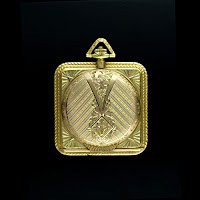What is Dieselpunk?
WikiPedia: "
Dieselpunk is shorthand to describe a fantasy society with an industrial level of development."
Dieselpunks.org says: "
Dieselpunk is a subculture and a genre of art blending the aesthetics of the 1920s through the early 1950s with today. To us, the 'diesel era' was a time colored by Art Deco, pulp heroes, swing music, and noir gum shoes." (Their site has
Dieselpunk and steampunk culture, articles, music, events, photos, and fashion.)
Is dieselpunk the same thing as steampunk? No. Dieselpunk is a darker, dirtier version of steampunk, with a distinct fascination and attraction for innovative machines, especially transportation vehicles of all types. Petroleum power replaces steam power in those machines, which can still be quite innovative.
There are two divisions in dieselpunk fiction--one includes a bent towards wartime (especially WWI - II) and the other involves post-apocalyptic visions of the present and future (often known as petrolpunk: think "MadMax"). The people who lived during the industrial revolution both admired and sometimes feared the new technologies that were rapidly shaping their world, and it is these sentiments that often come through in the fiction of those times.
In today's dieselpunk, larger-than-life airliners and ocean liners abound in art and fiction as a symbol of power and freedom. Art deco is the predominant style of fine art and of architecture. Clothing fashions tend to have a snappy military touch, most likely due to wars both real and fictitious. Epaulets for everyone!
Don't have any old airplanes lying about to disassemble and create your own 3-D dieselpunk art? No worries! This innovative company,
MotoArt, creates furnishings and more out of airplanes. All kinds of furniture,
all kinds of parts from airplanes. They have an
online store where you may purchase smaller (and less expensive) items to display in your home, as the larger pieces will set you back thousands of dollars. (
Piston lamp or
fuselage picture frame, anyone?)
If you would like to read and see more about this fascinating genre, check out the dieselpunk entry on
Dark Roasted Blend,
here. They trace the evolution and expansion of the genre from before WWII to the present day in pictures and words.
 |
| Tank Girl! |
And of course, the all-knowing
WikiPedia has extensive entries on the subject and all aspects thereof; my favorite section is the
list of dieselpunk movies. Of the post-apocalypse movies listed in Wiki that I have seen, I like the
Tank Girl movie from 1995 as an example just because it is fun, if a
wee bit ridiculous! Who says we can't have our fictional post-apocalyptic crisis and laugh at it too? Joking aside, the genre really does expand on and fit with the imaginative aspects of steampunk that we like so much. I hope you have enjoyed this look into dieselpunk!
~ DS






























